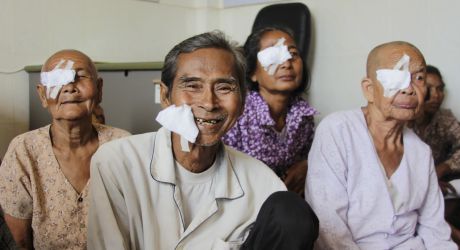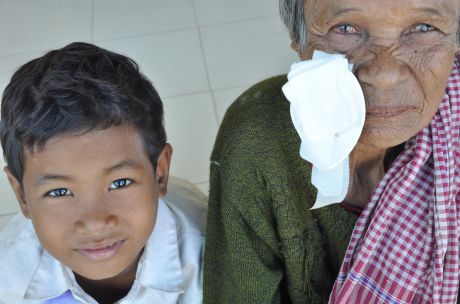Project Background
More than 90% of blindness in Cambodia is avoidable. People are blind because they are poor, and poor because they are blind. Many people either can’t afford the operation or don’t know it’s available to them.
Unfortunately, eye care services are still limited in quality and availability, particularly outside the urban centres, and there is a huge shortage of government funding available for eye care activities. Furthermore, there is inefficient equipment and consumables for service provision at eye units and referral hospitals.
It is estimated that uncorrected refractive error accounts for up to 10% of blindness in Cambodia. Insufficiency of services, personnel, training institutions and affordable glasses are the main contributing factors to uncorrected refractive error.
Project Overview
It is estimated that uncorrected refractive error accounts for up to 10% of blindness in Cambodia. Insufficiency of services, personnel, training institutions and affordable glasses are the main contributing factors to uncorrected refractive error.
The National Refraction Training Project has already more than doubled the number of refractionists and established a good foundation for establishing sustainable refraction services in Cambodia.
In 2017, three vision centres were built to increase access to eye care services and reduce rates of uncorrected refractive error and avoidable blindness. These centres were equipped with more than $65,000 worth of equipment, and 10 refractionists were trained to support the centres.
Project Outcomes
- Established one vision centre
- Screened 517 patients
- Trained 3 refractionists

Case Study: Thol
There are many heart-breaking examples of avoidable blindness, but Thol and her family were one of the most devastating.
Thol was living with her four children. When she was pregnant with her youngest, baby Cheet, she developed cataract blindness in both eyes. If that wasn’t bad enough, her husband abandoned her – he didn’t want a wife who was blind.
With four children to support, Thol found herself alone and reliant on her children for her food and care. She couldn’t work or move around freely so she spent her days isolated in their makeshift home – a tiny bamboo structure balanced on a wooden platform to keep the floodwater at bay. There was barely any shelter: when it rained, the family huddled under a rickety tin roof and a torn plastic sheet.
Her three eldest children couldn’t go to school and spent their days fishing or collecting and selling bags of rubbish for a meagre sum. Thol would stay at home. Unable to keep an eye on her baby, she’d constantly reach for Cheet, afraid that he would crawl off the platform and hurt himself.

Thol lived a mere 10 minutes away from the nearest hospital - but there was no eye surgeon.
The history of Cambodia means that today, there is a severe lack of eye-care services. In a country of 15 million people, there are only 34 eye surgeons. For people like Thol, who live in rural areas and who can barely afford the food they eat, travelling to seek help is nearly impossible.
Luckily, Dr Sarath was able to travel to Thol’s town. He’s a young Cambodian surgeon who was trained in cataract surgery with the support of The Fred Hollows Foundation. Now he spends his time restoring sight to as many fellow Cambodians as he can.
Even before her eye patches were removed, Thol knew that her life had changed. As Dr Sarath removed Thol’s patches, her children waited in tense hope.
Thol opened her eyes. She took baby Cheet’s face in her hands and saw him for the first time. “He’s fat!” she exclaimed.
When Thol could see again, the smiling faces of her beautiful children beamed back at her. But she also saw the condition of her home and surrounds. It shocked her. This wasn’t the life she wanted for her children.
These days, she’s selling vegetables and her older children are going to school. They don’t have to fight for their survival. They can be kids again. They’re being looked after and baby Cheet is now playing happily under his mother’s watchful eye.

What Next?
The Fred Hollows Foundation will continue to work in Cambodia to ensure avoidable blindness is eliminated. This will occur through screening and performing surgeries to restore sight, strengthening the local workforce to get the job done, providing infrastructure and equipment, and educating local populations on eye health.
Can I Visit the Project?
Interested donors should contact The Foundation.
Project Background
More than 90% of blindness in Cambodia is avoidable. People are blind because they are poor, and poor because they are blind. Many people either can’t afford the operation or don’t know it’s available to them.
Unfortunately, eye care services are still limited in quality and availability, particularly outside the urban centres, and there is a huge shortage of government funding available for eye care activities. Furthermore, there is inefficient equipment and consumables for service provision at eye units and referral hospitals.
It is estimated that uncorrected refractive error accounts for up to 10% of blindness in Cambodia. Insufficiency of services, personnel, training institutions and affordable glasses are the main contributing factors to uncorrected refractive error.
Project Aims & Outcomes
A key outcome of the project is the establishment of 12 vision centres over the life of the project (2013-2017). The centres will be established at district and provincial hospitals where it has been identified that no eye care services currently exist.
The vision centres will increase access to eye care services and streamline patient referral to provincial eye units for further management and treatment. This increased access to services will reduce rates of uncorrected refractive error and avoidable blindness.
The Cambodian Ministry of Health will provide a room at each hospital to establish the centres as well as fund the ongoing staff and utility costs.
The refurbishment, furniture, equipment, tools and ongoing maintenance, including 200 pairs of spectacles, will be provided by The Fred Hollows Foundation, in collaboration with project partners.
In 2017, this project aims to:
- Establish 3 Vision Centres
- Distribute 200 spectacles
- Train and support 10 opthalmic nurses

Part of a Larger Project
Thanks to the work of The Fred Hollows Foundation, the prevalence of blindness has declined by 68% since The Fred Hollows Foundation began working in Cambodia in 1998.
This project has already more than doubled the number of refractionists and established a good foundation for establishing sustainable refraction services in Cambodia.
Continued investment is required to ensure sustainable and high quality services reach those most in need.
